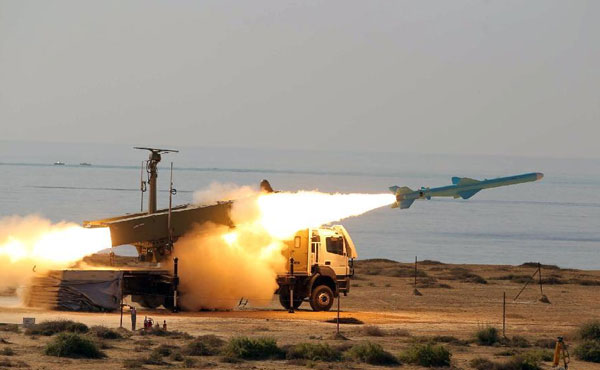Iran wraps up naval drill
 0 Comment(s)
0 Comment(s) Print
Print E-mail
Xinhua, January 4, 2012
E-mail
Xinhua, January 4, 2012
Iran wrapped up its 10-day navy drill in its southern waters on Tuesday while the Iranian Navy Commander Rear Admiral Habibollah Sayyari described it as "successful."
|
|
|
An Iranian missile is launched during Iranian naval maneuvers dubbed Velayat 90 on the Sea of Oman, Iran, Jan. 2, 2012. Iran successfully test-fired long range and short range missiles during its military drill in the Strait of Hormuz on Jan. 2, 2012. [Xinhua] |
On Tuesday, Iran ended its naval drill in the Persian Gulf, the Strait of Hormuz and the Sea of Oman, which began on Dec. 24 amid increased tensions between Iran and the West over Tehran's controversial nuclear program.
The naval forces "successfully" conducted the war games, Sayyari said, quoted by the official IRNA news agency.
The war games were staged to demonstrate the combat readiness and ability of Iran's naval forces to defend the country's territorial waters, he said, adding that Iran's Navy plans to broaden the scope of military drills next year.
The Iranian forces should enhance its combat readiness by acquiring sophisticated and modern weapons and equipment and augment their technological know-how, he was quoted as saying.
On Monday, Iran test-fired long- and short-range missiles during its military drill in the Strait of Hormuz. The home-made, coast-to-sea Qader (Mighty) missile fired on Monday could hit the target "successfully" and could destroy it, said the official IRNA news agency.
Deputy Commander of Iran's Navy Rear Admiral Seyyed Mahmoud Mousavi was quoted as saying by IRNA on Monday that the ultra- advanced Qader missile has been upgraded in terms of its radar and satellite systems, as well as in its accuracy of hitting targets, its range, and smart radar-evading systems in comparison with its previous generations.
The surface-to-surface missile of Noor (Light) was also launched by the Iranian navy in the drills on Monday, Mousavi said, adding that the ultra-advanced Noor missile has also been upgraded in comparison with its previous generations.
The launch of the missiles came one day after the Islamic republic test-fired an anti-radar, mid-range missile during the naval drills in its southern waters.
Mousavi was reportedly added on Monday that some observers from the "friend and allied" countries of the Islamic republic were witnessing some operations of Iranian navy during the drill.
Iran's submarines also hit pre-determined targets during the exercises, using domestically-manufactured torpedoes.
On Tuesday, Iran's Army Commander Major General Ataollah Salehi warned against the return of the U.S. aircraft carrier to the Persian Gulf, the semi-official Fars news agency reported.
The U.S. aircraft carrier had left the Persian Gulf to the Sea of Oman during Iran's recent navy drill in the Strait of Hormuz, said the report.
Salehi made the remarks on the sidelines of the parade held in Iran's southern waters to mark the end of the country's 10-day drill.
"We advice this (U.S.) aircraft carrier not to return to the Persian Gulf because we will not stop just on advice," Salehi was quoted as saying by Fars.
"At the beginning of the drill we saw the U.S. aircraft carrier left the Persian Gulf, passed through the Strait of Hormus and stationed in the Sea of Oman," said Salehi.
"We advice and warn them not to return to their previous position in the Persian Gulf because we are not used to repeating our warnings and we warn just once," the Iranian Army commander was quoted as saying.
"Our move in the sea is neither passive nor aggressive but for safeguarding the interests of the Islamic republic and the Islamic states. The friends of the Islamic republic need to know that it would be better (for them) if they rely on a brother country like Iran rather than the West," he said.
On Dec. 29, Iranian navy's deputy commander Seyyed Mahmoud Mousavi said that the Iranian naval forces detected a U.S. aircraft carrier in the area of the navy's military exercise.
The commander, also the spokesman for the maneuver, said that an Iranian navy's aircraft has shot images of the U.S. carrier spotted in an area where Iran's naval units were stationed for the drill.
On Dec. 28, the Pentagon warned Iran against any attempt to block the Strait of Hormuz, one of the world's most critical oil routes.
"This is not just an important issue for security and stability in the region, but an economic lifeline for countries in the Gulf, including Iran," Pentagon press secretary George Little said, " interference with the transit or passage of vessels through the Strait of Hormuz will not be tolerated."
The remarks came after Iran's top officials threatened to seal off the important oil passage.
Both Iran's First Vice President Mohammad-Reza Rahimi and Sayyari warned that Tehran would close the Strait of Hormuz if its oil exports were sanctioned by the West.
In another response to Iran's threat, the Bahrain-based U.S. Fifth Fleet said "anyone who threatens to disrupt freedom of navigation in an international strait is clearly outside the community of nations. Any disruption will not be tolerated."
Concerns have been raised over Iran's threat to close the Strait of Hormuz in face of Western sanctions on its energy sector.






